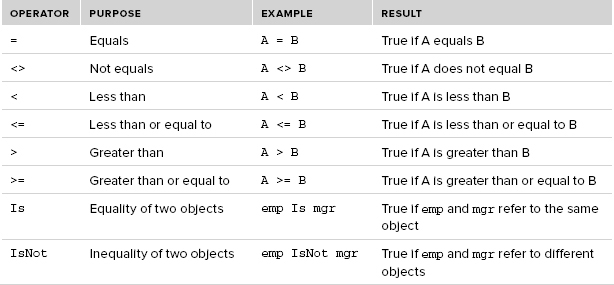COMPARISON OPERATORS
Comparison operators compare one value to another and return a Boolean value (True or False), depending on the result. The following table lists the comparison operators provided by Visual Basic. The first six (=, <>, <, <=, >, and >=) are relatively straightforward. Note that the Not operator is not a comparison operator, so it is not listed here. It is described in the next section, “Logical Operators.”


The Is operator returns True if its two operands refer to the same object. For example, if you create an Order object and make two different variables, A and B, point to it, the expression A Is B is True. Note that Is returns False if the two operands point to different Order objects that happen to have the same property values.
The IsNot operator is simply shorthand for a more awkward Not . . . Is construction. For example, the statement A IsNot Nothing is equivalent to Not (A Is Nothing).
The value Nothing is a special value that means not an object. If you have an object variable, you can use the Is or IsNot operator to compare it to Nothing to see if it represents anything. Note that you cannot use Is or IsNot to compare an object variable to 0 or some other numeric value. Is and IsNot work only with objects such as those stored in variables and the special ...
Get Visual Basic 2012 Programmer's Reference now with the O’Reilly learning platform.
O’Reilly members experience books, live events, courses curated by job role, and more from O’Reilly and nearly 200 top publishers.

